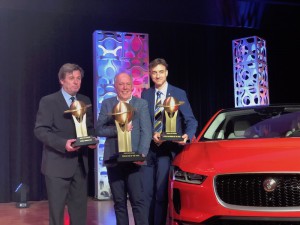
Jaguar's Ian Callum, center, celebrates the I-Pace being named World Car of the Year at the New York International Auto Show.
It’s not common to find Ian Callum, the normally garrulous Jaguar global design chief, at a loss for words, but that’s precisely what happened, at least momentarily, when the British automaker’s first battery-electric vehicle, the I-Pace, was named World Car of the Year during a ceremony at the New York International Auto Show Wednesday morning.
Of course, it didn’t hurt that Jaguar pulled off a first-ever hat trick during the show’s media preview, also being named World Car Design of the Year as well as World Green Car of the Year.
“I’m speechless for once,” said Callum, taking a deep breath before regaining his composure as he accepted the third – and most important – trophy of the morning. “This is astonishing — my Oscar moment.”
It’s a moment many would have considered completely unlikely just a few years ago. But the strong performance of the I-Pace helped to set the stage for the dramatic transformation of the auto industry that will become readily apparent to anyone attending the 2019 NYIAS.
(Jaguar rethinking its line-up as market continues shifting to SUVs. Click Here for the story.)
Jaguar serves as the poster child for that transformation. For decades, the automaker steadfastly refused to swerve from its traditional roots, building exotic coupes, sedans and sports cars. Even a station wagon took more than a decade of debate.
It was only mid-decade that Jaguar bowed to the inevitable, launching the first of what are now three SUVs. The debut of the F-Pace came at a time when utility vehicles were rapidly displacing conventional passenger cars as the vehicles of choice for luxury buyers.
Those three utes now generate the majority of Jaguar’s global sales. But the I-Pace is more than just another crossover, marking Jaguar’s first model to be powered entirely by batteries.
“The team set out to build the best car in the world,” said Callum, while also noting how “Electric cars give us more freedom to do what we want to.”
(Click Here for our first look at the 2020 Jaguar XE.)
Part of the appeal of the Jaguar battery-electric vehicle is the way it takes some of the space normally devoted to a gas or diesel engine and repurposes it for a bigger cabin and cargo compartment.
It’s not that the I-Pace didn’t have tough competition in all three categories.
For World Car if the Year, for example, it went up against both the Volvo S60/V60 Line, as well as the all-new Audi e-trim. That in itself created something of a historic moment, with two of the three World Car of the Year finalists purely battery powered.
Of course, there were also some more conventional choices in other categories. In the World Performance Car category, the McLaren 720S topped the Aston Martin Vantage and the Mercedes-AMG 4-Door Coupe.
(Jaguar Land Rover cutting 4,000 jobs in Europe. Click Here for the story.)
The Suzuki Jimmy was named World Urban Car, besting the Kia Soul and the Hyundai AH2. And the Audi A7 nabbed the trophy in the World Luxury Car category, beating out the BME 8-Series and a second Audi finalist, the new Q8.
